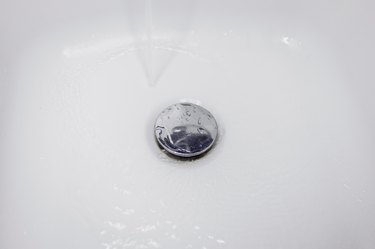
It's easy to take drains and drainpipes for granted until they begin to run slowly — or become completely clogged. Water isn't the only thing that runs down the drain; food, grease, oil, makeup, hair, soap, sand and dirt all tend to go right along with it. These materials adhere to the insides of pipes and gradually accumulate until water flow is severely restricted or stopped.
Dirt or mud accumulation can be the most frustrating, as common household drain cleaners can't chemically react to dissolve dirt and flush it away. As the dirt gets compacted and saturated with water, it can turn to tough and almost cement-like mud. Fortunately, a drain snake is effective tool for unclogging a drain blocked with mud or dirt.
Video of the Day
Video of the Day
Preparing to Snake Mud in Drain Pipes
First, determine whether a manual snake, electric snake or one powered by a hand-held electric drill best suits your needs. Generally, the more severe a clog, the better off you are with a powered model. Look into renting a drain snake if you don't want to purchase one for infrequent use.
Clear the work area of all obstructions to make it easier to move around and maneuver the drain snake. Protect valuables from getting damaged or broken, or from getting splashed with anything that might come out of the drain.
Place towels nearby to clean up any water or debris. If unclogging a floor drain, form a protective dam with towels to keep water and debris close by. Attach the power drill to the the drain snake if you're using that design.
Feeding the Snake Into the Drain
Remove the drain strainer or grate to access the outside drain clogged with dirt. Put on leather gloves for this task, as thin rubber gloves are dangerous as they can get caught in the coils and tighten around your hand. Feed the snake into the drain. Rotate the head by hand if using a manual drain snake, or turn on the electric snake or power drill.
Continue feeding the snake into the drain blocked with mud until you feel an obstruction and the auger at the tip secures it. Withdraw the snake while pulling it through a towel to clean it, and deposit any debris in the bucket. If the snake won't grab the obstruction, pull back slightly and then continue to feed it into the pipe. This should cause the auger to chew its way through the obstruction. Remove the snake when no obstructions are felt and most of the snake has been inserted into the pipe.
Testing for Proper Drainage
Attach a garden hose to a water source. Feed the garden hose into the drain pipe, wrap towels around the hose and block the rest of drain to keep water from splashing out. Turn on the water supply slowly, check to make sure the pipe is unobstructed, then gradually increase water flow until it begins flowing back out of drain. Continue flushing the pipe to remove any residual dirt in the line.
Make sure water flow down the drain is adequate. If not, repeat the process. Finally, withdraw the hose and clean up the work area.
If you can't restore regular drain flow or if you encounter obstacles you're unable to overcome, contact a licensed plumber.